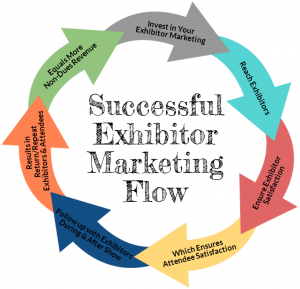Make Your Exhibitor Marketing Campaign a Success
When thinking about marketing events, many associations focus the majority of their time and efforts on attendee marketing. After all, registration fees make up a significant slice of many associations’ non-dues revenue pie. However, if your event or workshop includes a trade show floor, exhibitor marketing should be in your event plans from the start.
Give yourself plenty of time to plan

Marketing your trade show to exhibitor prospects shouldn’t start a month or two before your event – it should start 6 to 12 months in advance. In fact, some of our clients get a large percentage of their exhibitors to renew for the following year with on-site registration at the current year’s show.
At Naylor’s AMD Group, we start planning the exhibitor outreach for clients’ future shows 13 months ahead of time: about a month before the first show even starts! We aim to have a new concept and marketing plan started a full year in advance. This gives us appropriate time to measure/research what worked and didn’t work in the previous year. Plenty of time is needed to conduct quantitative and qualitative surveys, meet with large clients to gain their detailed feedback, share our insights with the association client, and reach a consensus on appropriate changes for the next show.
In short, we give ourselves plenty of time to thoroughly research the needs of exhibitors and strategize for making future improvements to a trade show experience.
![]()
Give yourself at least one year to create and execute an exhibitor marketing plan.
Allocate sufficient funds for your exhibitor marketing plan. Think of the cost as an investment in your show, and the non-dues revenue you’ll earn as the payoff.
Create written schedules that will help your staff track needed tasks and progress toward exhibitor goals.
Allocate sufficient funds for your exhibitor marketing
You can’t expect to expand your reach, increase marketing efforts and reach new prospects without allocating the appropriate funds.
While your staff may be constrained by bylaws or other rules dictating funds available for events and event marketing, consider this: You must spend money to make money. The more exhibitors you can reach, the more who enlist to exhibit at your show, the more you invest in making their marketing/selling experience a satisfactory one (this bleeds into taking steps to ensure attendee satisfaction), the more likely exhibitors will return to your trade show next year – and recommend your event to other potential exhibitors – and the more non-dues revenue your association has the potential to collect.
It’s the circle of life, trade show-style.
Not every marketing strategy or tactic incurs a high cost. Some marketing tools that are free or low-cost include:
- Email marketing: Find a service that allows you to do A/B testing of subject lines, email personalization, or include graphics in your emails so you can pinpoint the exact style of messaging that makes your trade show proposition resonate the most.
- Social media: Find the platforms your exhibitor audience uses the most and meet them there with messaging about the opportunity to exhibit at your next event. Quick info in casual social environments sometimes grabs the attention of vendors more than email or offline marketing.
- Your website: Don’t ignore your website! Keep it relevant as your association’s central information hub by posting all exhibitor information in a special section that is easily accessible from the home page or from search engine results. Don’t make it difficult for someone interested in exhibiting at your event to reach out to you, or to find more information once they’ve seen your emails/social media posts/offline marketing pieces.
Other marketing tools have a cost, but they can be worth the investment in your future non-dues revenue returns:
- Direct Mail: Snail mail is making a comeback as a tool that catches the eye of people who slog through hundreds of emails a day on their computers at work, their laptops at home, and their smartphones in the car or on the train. Receiving mail is still fun for most people, and jostling for mailbox space has calmed down with the advent of email, social media, texting and other electronic communication.
- Phone calls: While your association might not have to pay extra to place more calls to exhibitors above your normal call volume, the expense here comes in the form of staff time. However, as with snail mail, picking up the phone and placing a call to a potential exhibitor whose interests match up with the attendee audience your event can deliver carries a personal touch that is usually well-received.
However you decide to allocate your exhibitor marketing budget, make sure you use clear calls to action across tactics that tell exhibitors what’s in it for them should they choose to join your event. Clearly state the benefits of exhibiting, which could include branding, wider exposure, meeting new clients, meeting quality prospects or introducing something new with a splash.
Execute your marketing plan
Once you have a plan and a budget in place, stay on track!
- Create written schedules that will help your staff track needed tasks and progress toward exhibitor goals.
- Know what’s important to your exhibitors and stay on that message.
- Communicate effectively, but don’t overdo it: Stay focused on the potential exhibitors who respond to your efforts; leave the ones who don’t in the “next year” pile.
Measure your efforts throughout the campaign: This is important for making mid-year adjustments to your plan to ensure that your association is using its budget and other resources as efficiently as possible. Collect feedback from your internal team, specifically sales, at least biweekly. It’s important to keep your team in the loop on strategy, ongoing tactical efforts and upcoming marketing items. What are the roadblocks that sales are hearing? Make sure your marketing material covers those concerns as soon as you uncover them.
Follow up with exhibitors throughout the year
Satisfaction with an exhibit experience isn’t defined by just the event itself, but by how the host treats an exhibitor throughout the year. Keep in touch with your exhibitors and let them know how much your association values their participation. Use surveys, phone calls and other efforts to steward your association’s relationship with them. This type of effort keeps favorite exhibitors coming back year after year. Stewardship also gives your exhibitors a chance to share their perspective about the event with your staff and, in turn, gives your staff an opportunity to share how your association is continually working to improve the next event. It’s that circle of life cycle that characterizes well-planned event marketing!
For example: The New York State Association of Fire Chiefs (NYSAFC) holds its FIRE event yearly. More than 180 exhibitors have exhibited for three or more years in a row. The association (and its Naylor partners) knows what event activities and setups are important to exhibitors and attendees. NYSAFC intentionally communicates its event improvements and changes to exhibitors throughout the year, and, in return, exhibitors reserve booth space year after year. They see the value in exhibiting that is promoted.
Planning your association’s exhibitor marketing is a surefire way to increase non-dues revenue because it forces your staff to carefully consider the exhibitor experience and improve upon it. Set a plan, fund the plan and work the plan, and watch your non-dues revenue work for you.



